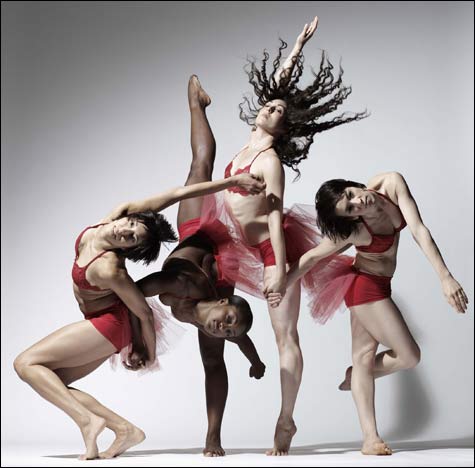
BUD SUITE: Amazing bodies in an orgy of sensuous motion. |
“One’s self I sing, a simple separate person. . . . Of physiology from top to toe,” goes one of the Walt Whitman poems set by Rufus Wainwright for Stephen Petronio’s Bloom. Those words describe Petronio’s dance temperament as well as anything could. Although you find groupings and relationships in his work, both the ensembles and the big dance effects rely on individuals invested to the max in their own movement. A Whitmanesque celebration.The Stephen Petronio Company returned last weekend after five years, sponsored by CRASHarts, to inaugurate the Institute of Contemporary Art’s Barbara Lee Family Foundation Theater. Most of the season’s coming CRASHarts dance attractions will play the comfortable new space.
Petronio’s Bloom and its prefatory dance, Bud Suite, had music by the eclectic Wainwright, whose arch and sometimes ponderous texts evoked a post-adolescent seeker after sex, identity, and God. Unlike the over-amplified rasp and screech that we usually have to tolerate in dance performances, Wainwright’s brainy scores emerged wonderfully well through the new theater’s excellent sound system. The clarity of musical transmission might even have distracted me a little from the dancing, but the verbal back-up did give character to what’s essentially an abstract dance style. Petronio’s advance publicity rhapsodized about “the openness and purity of youth,” “particular innocence,” stuff I wouldn’t have gotten from the sophisticated, high-powered dancing alone.
Costumes spiced up the scene too. Bud Suite begins with a quasi-romantic duet for Michael Badger and Gino Grenek, who are wearing opposite halves of two suggestive costumes bisected — a suit jacket and a gladiator’s torso straps. Later, a trio of women have similarly schizoid costumes — white men’s shirt fronts and pink tutus sticking out over their backsides.
The audience giggles at the sight of this goofiness, as it does when Wainwright sings about how his phone is set on “Vibrate” for his lover. To my eyes the choreography doesn’t reflect the irony or the absurdity of these settings. What it does do is throw these amazing bodies at you in an orgy of sensuous motion. The other dancers were Elena Demianenko, Jonathan Jaffe, Shila Tirabassi, and Amanda Wells.
No single part or sector of the body dominates Petronio’s movement style. One minute the dancers are leaping or jumping, the next they’re undulating their torsos, throwing themselves to the side, stretching into huge extensions. They can generate big movements from the arm, the neck, the hip, make you notice tiny skips or turns of the head. There are few transitions or hesitations between movement phrases, and the main dynamic is agitato. Everything is strong and committed and could change at any moment, until the end of a musical section draws the participants to a stop if not a resolution.
In addition to the Wainwright pieces, the company revived The Rite Part, which it calls vintage Petronio, an excerpt from his 1992 Full Half Wrong, which is based on the devastating Stravinsky/Nijinsky ballet Le sacre du printemps. Both the movement and the choreography in this work seemed more structured, more linear, with a trajectory that took it beyond thrill.